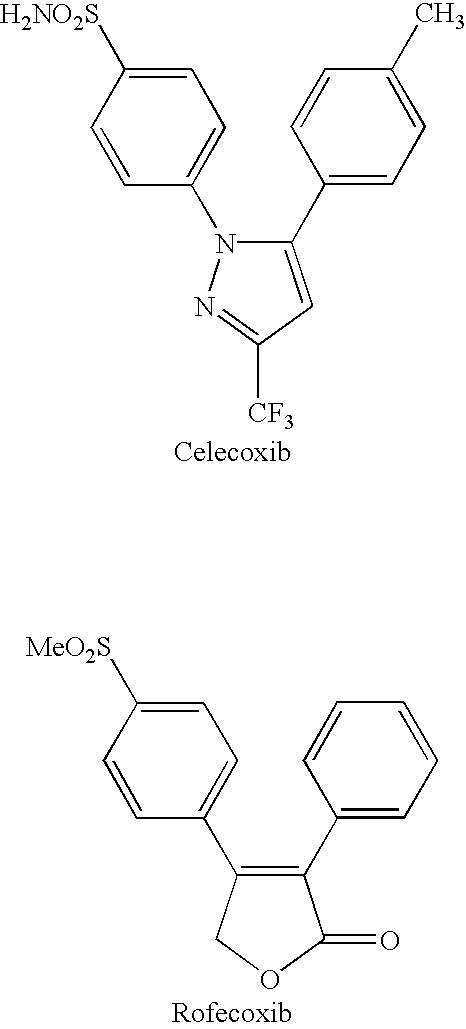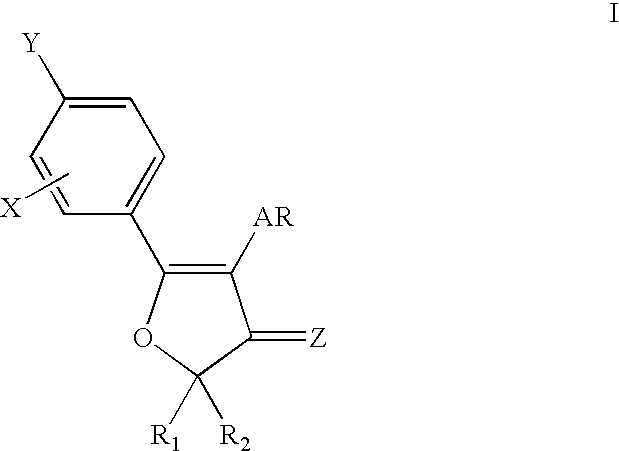4,5-diaryl-3(2H)-furanone derivatives as cyclooxygenase-2 inhibitors
a technology of cyclooxygenase and derivatives, which is applied in the field of novel selective cox2 inhibitors, can solve the problems of limiting clinical use, ulceration and bleeding, and life-threatening toxicities of the gastrointestinal tra
- Summary
- Abstract
- Description
- Claims
- Application Information
AI Technical Summary
Problems solved by technology
Method used
Image
Examples
example 1
##STR19##
2,2-Dimethyl-4-(4methylphenyl)-5-{4-(methylsulfonyl)phenyl}-3(2H)-furanone
Step 1: Preparation of 1-{4-(methylthio)phenyl}-4-hydroxy-4-methyl-2-pentyn-1-ol
##STR20##
To a stirred solution of 2-methyl-3-butyn-2-ol (416 mg) and dry THF (30 ml) under argon and at -78.degree. C., was added 1.6 M butyllithium in hexane (5 ml) dropwise over 10 minutes. 20 minutes later, p-methylthiobenzaldehyde (0.5 ml) was added dropwise to the reaction solution. Then the reaction solution was allowed to warm up to the ambient temperature by removing the cold bath. After stirring the reaction mixture for 2 hours, the reaction solvent was removed in vacuo, which was followed by neutralization with dilute aqueous HCl solution. The reaction mixture was then extracted with dichloromethane (50 ml.times.3), and the dichloromethane layer was washed with water (50 ml.times.1). The dichlomethane layer was concentrated in vacuo and the resulting residue was subjected to column chromatographic separation (hex...
example 2
##STR25##
4-(3-Chloro-4-fluorophenyl)-2,2-dimethyl-5-{4-(methylsulfonyl)phenyl}-3(2H)-furanone
To a stirred solution of 4-bromo-2,2-dimethyl-5-{4-(methylsulfonyl)phenyl}-3(2H)-furanone (112 mg) and tetrakis(triphenylphosphine)palladium(0) (54 mg) in 7 ml benzene and 1 ml ethanol, were added 2 M aqueous sodium carbonate (0.22 ml) and (3-chloro-4-fluorophenyl)boronic acid (82 mg). The reaction solution was kept at reflux for 24 hours. Then the solvent was evaporated off under reduced pressure. The resulting residue was extracted with 50 ml water and dichloromethane (50 ml.times.3). The organic layer was concentrated in vacuo and the resulting residue was separated by column chromatography (hexane / ethylacetate) to yield 32 mg of 4-(3-chloro-4-fluorophenyl)-2,2-dimethyl-5-{4-(methylsulfonyl)phenyl}-3(2H)-furanone as a solid. mp: 162-164.degree. C. NMR: .delta.1.58 (s, 6H), 3.09 (s, 3H), 7.13 (m, 2H), 7.40 (d, J=6.6 Hz, 1H), 7.83 (d, J=8.1 Hz, 2H), 7.97 (d, J=8.1 Hz, 2H). IR (cm.sup.-1): 2...
example 3
##STR26##
2,2-Dimethyl-4-(4-methoxyphenyl)-5-{4-(methylsulfonyl)phenyl}-3(2H)-furanone
To a stirred solution of 4-bromo-2,2-dimethyl-5-{4-(methylsulfonyl)phenyl}-3(2H)-furanone (220 mg), 1,3-bis(diphenylphosphino)propane (24 mg) and palladium(II) acetate (6.1 mg) in 30 ml benzene, were added 2 M aqueous sodium carbonate (0.22 ml) and 4-methoxybenzeneboronic acid (90 mg). The reaction solution was kept at reflux for 24 hours. Then the solvent was removed under reduced pressure. The resulting residue was purified by a procedure similar to the purification method in Example 2 to yield 55 mg of 2,2-dimethyl-4-(4-methoxyphenyl)-5-{4-(methylsulfonyl)phenyl}-3(2H)-furanone as a solid. NMR: .delta.1.56 (s, 6H), 3.07 (s, 3H), 3.83 (s, 3H), 6.92 (d, J=8.7 Hz, 2H), 7.23 (d, J=9.0 Hz, 2H), 7.89(dd, J=8.7, 8.7 Hz, 4H). IR (cm.sup.-1): 2925, 1697, 1592, 1149, 1031, 912, 745.
PUM
| Property | Measurement | Unit |
|---|---|---|
| temperature | aaaaa | aaaaa |
| temperature | aaaaa | aaaaa |
| volumes | aaaaa | aaaaa |
Abstract
Description
Claims
Application Information
 Login to View More
Login to View More - R&D
- Intellectual Property
- Life Sciences
- Materials
- Tech Scout
- Unparalleled Data Quality
- Higher Quality Content
- 60% Fewer Hallucinations
Browse by: Latest US Patents, China's latest patents, Technical Efficacy Thesaurus, Application Domain, Technology Topic, Popular Technical Reports.
© 2025 PatSnap. All rights reserved.Legal|Privacy policy|Modern Slavery Act Transparency Statement|Sitemap|About US| Contact US: help@patsnap.com



